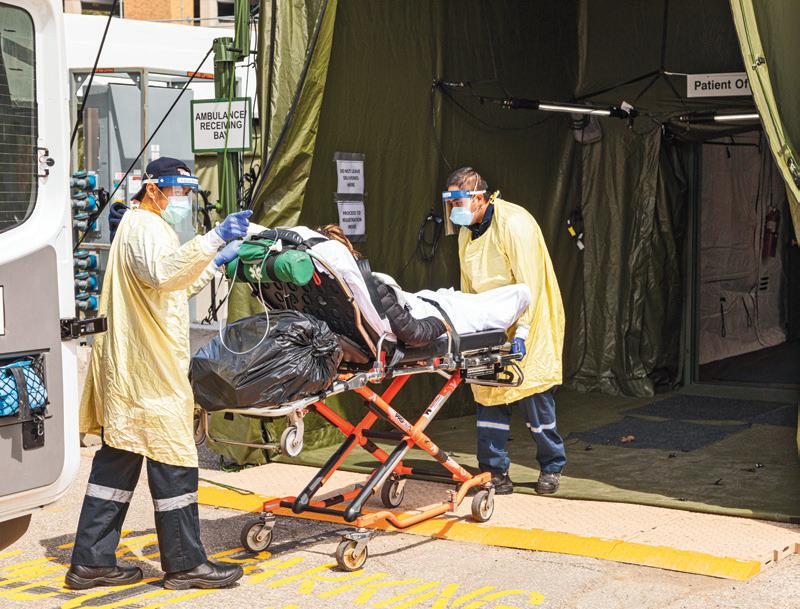
54 minute read
Guest Editorial
An open letter to Ontario’s ‘missing’ patients: Health care providers are ready to help you
By Harindra Wijeysundera and Patrice Lindsay
When you think about how COVID-19 has impacted the health of people living in Ontario, it’s natural that your mind goes first to the more than 500,000 who have already been infected, the tragedy in long term care, the plight of essential workers and the uneven burden this pandemic has placed on lower socioeconomic and racialized communities. How to care for those with COVID-19 and protect those most at risk has rightly been top of mind for health care practitioners and public health experts for almost fourteen months.
However, there is a side to the pandemic that has not received the attention it deserves – the impacts on people accessing other kinds of care, in particular, for time sensitive conditions such as heart disease and stroke. These are the untold victims of the COVID-19 pandemic. Untold, because so many of these patients have disappeared from hospitals, clinics and doctors’ offices and even emergency departments. Today we, and on behalf of our health-care colleagues, are writing to them: Ontario’s missing patients.
To you, the missing patient, we want to say this: we’re worried about you.
We are worried you might be ignoring changes to your health because you don’t want to place additional burden on a system that you keep hearing is overwhelmed. Perhaps you feel you would not receive the quality of care you normally would. Or you might be concerned about contracting COVID-19 in our hospitals and clinics.
We understand your concerns, but we want to reassure you; while our health care system is very stretched, it is not broken. We want you to know that more than a year into this, we have learned a lot and we have applied what we have learned, including how to protect and care for you when you come to see us.
If you experience signs of a medical emergency like a heart attack or stroke, you should call 9-1-1 immediately. For heart attack, these signs include chest or upper body discomfort, sweating and nausea. In the case of stroke, watch for weakness on one side of your body, changes to speech or drooping of the face.
Continued on page 6
UPCOMING DEADLINES
AUGUST 2021 ISSUE
EDITORIAL: July 6 ADVERTISING: Display – July 23 | Material – July 27 Monthly Focus: Paediatrics/Ambulatory Care/Neurology/ Hospital-based Social Work: Paediatric programs and developments in the treatment of paediatric disorders including autism. Specialized programs offered on an outpatient basis. Developments in the treatment of neurodegenerative disorders (Alzheimer’s, Parkinson’s etc.), traumatic brain injury and tumours. Social work programs helping patients and families address the impact of illness.
SEPTEMBER 2021 ISSUE
EDITORIAL: August 10 ADVERTISING: Display – August 20 | Material – August 24 Monthly Focus: Emergency Services/Critical Care/Trauma/ Emergency: Innovations in emergency and trauma delivery systems. Emergency preparedness issues facing hospitals and how they are addressing them. Advances in critical care medicine. A look at medical imaging techniques for diagnosis, treatment and prevention of diseases. + ONLINE EDUCATION SUPPLEMENT + SPECIAL FOCUS: EMERGENCY ROOM
610 Applewood Crescent, Suite 401 Vaughan Ontario L4K 0E3 TEL. 905.532.2600|FAX 1.888.546.6189 www.hospitalnews.com
Editor Kristie Jones
editor@hospitalnews.com Advertising Representatives Denise Hodgson
denise@hospitalnews.com Publisher Stefan Dreesen
stefan@hospitalnews.com Accounting Inquiries accountingteam@mediaclassified.ca
Circulation Inquiries info@hospitalnews.com
Director of Print Media Lauren Reid-Sachs
Senior Graphic Designer Johannah Lorenzo
ADVISORY BOARD
Barb Mildon,
RN, PHD, CHE VP Professional Practice & Research & CNE, Ontario Shores Centre for Mental Health Sciences Helen Reilly,
Publicist Health-Care Communications Jane Adams,
President Brainstorm Communications & Creations Bobbi Greenberg,
Health care communications Sarah Quadri Magnotta,
Health care communications Dr. Cory Ross,
B.A., MS.C., DC, CSM (OXON), MBA, CHE Vice President, Academic George Brown College, Toronto, ON
ASSOCIATE PARTNERS:
Hospital News is published for hospital health-care professionals, patients, visitors and students. It is available free of charge from distribution racks in hospitals in Ontario. Bulk subscriptions are available for hospitals outside Ontario. The statements, opinions and viewpoints made or expressed by the writers do not necessarily represent the opinions and views of Hospital News, or the publishers. Hospital News and Members of the Advisory Board assume no responsibility or liability for claims, statements, opinions or views, written or reported by its contributing writers, including product or service information that is advertised. Changes of address, notices, subscriptions orders and undeliverable address notifications. Subscription rate in Canada for single copies is $29.40 per year. Send enquiries to: subscriptions@ hospitalnews.com Canadian Publications mail sales product agreement number 42578518.
First minimally invasive maze procedure for atrial fibrillation performed in Ontario
By Anna Wassermann
The Cardiac Surgery team at St. Michael’s Hospital of Unity Health Toronto is the first in Ontario to complete a minimally invasive maze procedure to treat atrial fibrillation – the most common type of irregular heart rhythm.
The maze procedure is an effective surgical treatment for atrial fibrillation but it’s highly invasive and requires a lengthy recovery time. The minimally invasive technique used by surgeons at St. Michael’s will help patients with atrial fibrillation who haven’t found success with other treatments options, including medication and transcatheter ablation – a procedure that uses a small catheter to deliver energy to the heart, destroying the heart tissue causing the irregular rhythm.
“Our minimally invasive method achieves the same results as the traditional maze procedure but uses less invasive endoscopy techniques,” said Dr. Gianluigi Bisleri, the Cardiac Surgeon at St. Michael’s who led this procedure. “It’s going to improve care for patients with atrial fibrillation in Ontario who require surgical intervention.”
The technique used by Dr. Bisleri and his team involves a small, 1.5 inch incision on the side of the chest. A miniaturized camera and dedicated instruments are inserted to see the heart and then a probe is used to create barriers of scar tissue throughout the upper chambers of the heart. These barriers, which sometimes look like a maze, block the electrical signals causing the irregular rhythm.
The maze procedure is traditionally performed by opening the chest and stopping the heart. Dr. Bisleri and his team spent weeks preparing to be the first team to use the minimally invasive technique.
“We had time and space to practice the procedure in the operating room with all the necessary equipment,” said Dr. Bisleri. “We were able to complete several dry runs, which made a huge difference.”
Dr. Bisleri completed his medical education and cardiac surgical training in Italy before being recruited to Queen’s University and Kingston Health Sciences Centre in 2016, where he expanded the use of minimally invasive techniques for heart surgery in eastern Ontario.
His work in Kingston caught the attention of Heart and Vascular Program leadership at St. Michael’s, who recruited the cardiac surgeon to help build the first comprehensive minimally invasive cardiac program at the hospital – and in the city. He joined St. Michael’s in January.
“Recruiting Dr. Bisleri adds a critically important piece to our innovative Structural Heart Program, which to date has focused on cutting edge transcatheter heart valve therapies and traditional approaches to mitral valve surgery, including mitral valve repair,” said Dr. Mark Peterson, Medical Director of the BRAIN&HEART program at St. Michael’s and co-Director of the hospital’s Structural Heart Program.
The mitral valve separates the heart’s left atrium and left ventricle and ensures blood flows properly between them. Sometimes, it stops working properly and needs to be repaired.
“We’re committed to supporting Dr. Bisleri and the creation of an arrhythmia and minimally invasive mitral valve program. Minimizing the incision will allow patients to have high-quality mitral valve repair while regaining function and returning to their normal routine more quickly.”
For Dr. Bisleri, the promise of getting patients back on their feet more quickly – and being able to offer these minimally invasive procedures on a routine basis – is exciting.
“We have an opportunity here to position ourselves as a leader in this space, to show patients in need of cardiac surgery that in many instances, we can treat their condition without putting their heart and body through the stress of a major operation,” he said.
Two months into his new position, he’s already showing that this is possible. He’s now completed two minimally invasive maze procedures; in the second, he also repaired a patient’s mitral valve using minimally invasive techniques.
“I feel fortunate to be part of an organization that encourages innovation and that supported me in this novel endeavour,” said Dr. Bisleri. “I look forward to achieving even more firsts and expanding the portfolio of minimally invasive cardiac procedures with the support of the organization behind me.” ■ H

Anna Wassermann is a communications advisor at Unity Health Toronto.






IN BRIEF Postpartum mental health visits 30 per cent higher during COVID-19 pandemic
Mental health visits for new mothers were 30 per cent higher during the COVID-19 pandemic than before the pandemic, particularly in the first three months after giving birth, found new research in CMAJ (Canadian Medical Association Journal).
“Increased visit rates began in March 2020, although the state of emergency was declared only midway through the month, suggesting that distress related to the pandemic translated into an increased need for care very quickly,” writes Dr. Simone Vigod, chief of psychiatry, senior scientist and interim vice president of academics at Women’s College Hospital (WCH), and senior adjunct scientist at ICES in Toronto, Ontario, with coauthors.
Postpartum mental illness affects as many as 1-in-5 mothers and can have long-term effects on children and families if it becomes chronic.
Researchers looked at mental health visits by 137,609 people in Ontario during the postpartum period (from date of birth to 365 days after) from March through November 2020 and collected data on age, number of children, neighbourhood income based on postal codes, neighbourhood ethnic diversity and region of residence based on the province’s 34 public health units. They also divided the province into northern and southern public health units.
During the study period, mental health visits to both family physicians and psychiatrists were higher than before the pandemic, especially among parents with anxiety, depression, and alcohol and substance use disorders. People living in northern public health units had relatively low increases after July 2020, perhaps because of fewer COVID-19 restrictions in those areas during the latter period.
The way care was delivered during the pandemic period differed from the period before: 84.8 per cent of postpartum mental health visits were con-
Continued from page 4 Health care providers are ready to help you
But even if it’s not an emergency, let us assess you and determine if it is something that can be safely postponed. Changes to your health including increased lightheadedness, shortness of breath, tightness in the chest or jaw are all reasons to reach out.
The bottom line is simple: please don’t triage yourself. Let your health care provider do that – that’s our job and we are here for you. If we can assess you virtually, we will. If we need to see you in person, we will make sure that it’s done safely. And if your symptoms change, our approach will adapt.
But we can’t help you if you stay silent. The nature of cardiovascular disease is that your symptoms may be stable for a time, but then change very suddenly. In our world, days, hours, and even minutes can make a difference. The longer you wait, the more difficult your recovery will be – if you survive. So please don’t wait.
The consequences of COVID-19 on the health of Ontario’s missing patients are not hypothetical. Delaying heart and stroke care has very real and very serious consequences. Our health care system and the people who work in it have been challenged by COVID-19, but we are still here and ready to help you. Please let us. ■ H
Dr. Harindra Wijeysundera, MD, PhD is Chief of the Schulich Heart Program, Sunnybrook Health Sciences Centre and Canada Research Chair in Structural Heart Disease Policy and Outcomes. Dr. Patrice Lindsay, RN, PhD, is Director of Health Systems Change for Heart & Stroke. ducted virtually in April 2020 compared with only 3.1 per cent of visits in the pre-pandemic period.
The authors suggest that increased use of virtual care may have removed barriers to postpartum mental health support, such as the need to travel, find childcare for older children, or manage erratic schedules, enabling more people to seek care.
Patients in the lowest income neighbourhoods had the smallest increase in mental health visits compared with people in other neighbourhoods, which the authors noted with surprise.
“This raises some concern about the potential for unmet need because low-income patients may have greater barriers to accessing care, including difficulty affording the required technology or finding private space to attend virtual appointments (e.g., crowded homes), or less opportunity to attend “live” appointments because of employment in front-line jobs,” write the authors.
They recommend targeted approaches to providing mental health supports.
“Health systems should focus proactively on patients from high-risk groups, monitor waiting lists for care, and explore creative solutions to expand system capacity, with special attention to postpartum patients who may be experiencing barriers to care,” they advise.
“Postpartum mental illness during the COVID-19 pandemic: a population-based repeated cross-sectional study” was published June 7, 2021.■ H
Airborne transmission of SARS-CoV-2
calls for updated practices to prevent transmission
There is a growing body of evidence supporting airborne transmission of SARS-CoV-2, the virus that causes COVID-19. Despite updates from the World Health Organization, the U.S. Centers for Disease Control and Prevention (CDC) and the Public Health Agency of Canada that the virus can be transmitted by short- and long-range aerosols, Canada’s public health guidance has not been adequately updated to address this mode of transmission, argue authors of a commentary published in CMAJ (Canadian Medical Association Journal).
Canadian public health guidance and practices should be updated to include more emphasis on the following airborne mitigation measures: ventilation, filtration and better masks.
“Ventilation is a key element in the fight against airborne transmission. We need clear guidelines and funding for the assessment and improvement of ventilation in our indoor spaces, particularly our schools,” says Dr. Sarah Addleman, emergency physician, The Ottawa Hospital, Ottawa, Ontario.
Along with ventilation, it is time to revisit Canadian personal protective equipment (PPE) recommendations in health care and other essential settings.
“People who work in close proximity to others (in both health care and other settings) are at higher risk of infection from short-range aerosol inhalation, and better masks (such as N95s) are needed to prevent infection,” says coauthor Dr. Victor Leung, infectious disease physician, University of British Columbia, Vancouver, British Columbia.
“It took decades for the medical community to accept that tuberculosis and measles were airborne diseases. The science on airborne transmission of SARS-CoV-2 has, in contrast, moved fast. It is time for Canadian guidance and policies to follow swiftly too,” the authors conclude.
“Mitigating airborne transmission of SARS-CoV-2” was published June 8, 2021. ■ H
IN BRIEF COVID-19-related multisystem inflammatory syndrome in adults: rare but possible
In rare cases, adults who have recovered from COVID-19 may develop multisystem inflammatory syndrome, and clinicians should consider this possibility in adults with specific symptoms, as physicians describe in a case published in CMAJ (Canadian Medical Association Journal).
A 60-year-old man, who had tested positive for SARS-CoV-2 four weeks before, visited hospital for a range of symptoms, including prolonged shortness of breath, high fever, swelling and severe fatigue. Testing found an enlarged heart and lung swelling as well as other issues.
“Given the patient’s recent history of SARS-CoV-2 infection, fevers without localizing symptoms, oral mucosal changes, cervical lymphadenopathy, conjunctivitis and lower extremity changes, we suspected inflammatory post-COVID-19 syndrome. The presentation was similar to reported cases of an uncommon but severe complication in children and adolescents infected with SARSCoV-2, called multisystem inflammatory syndrome in children (MIS-C), as well as to Kawasaki-like illness,” write Drs. Genevieve Kerkerian and Stephen Vaughan, infectious disease specialists, Department of Medicine, Cumming School of Medicine, University of Calgary, Calgary, Alberta.
Prompt initiation of medication helped the patient to recover.
Previous cases of the syndrome in adults have been documented in people younger than 50. The authors suggest that age should not limit the potential diagnosis. Much is unknown about multisystem inflammatory syndrome in adults (MIS-A). “Unlike for MIS-C, there is currently no requirement to report cases of MIS-A to provincial or state authorities, but this should be encouraged to facilitate research and improve patient outcomes,” the authors conclude.
“Multisystem inflammatory syndrome in an adult after SARS-CoV-2 infection” was published June 21, 2021. ■ H
Expanded national After Stroke program
The March of Dimes Canada has launched an enhanced After Stroke program. The program will introduce a new personalized service model that supports survivors and their families to navigate the path forward after a stroke.
More than 62,000 people in Canada experience a stroke each year. Among them, 60 per cent are left with some level of stroke-related disability, and face a wide array of practical and emotional challenges as they move through their unique recovery journey. After discharge from hospital, many survivors and families face significant difficulties in identifying and accessing supports and services available in their community, compounding the isolation and stress caused by the stroke itself.
After Stroke aims to break through these barriers, with an individualized approach that helps people connect to the supports they need to rebuild their lives and achieve their evolving goals after a stroke. After Stroke is delivered through dedicated teams in Ontario, Nova Scotia and British Columbia, but stroke survivors and families in all provinces can access tools, resources and local referrals through the program.
People who have had a stroke and their families can engage with the After Stroke program at any point in their experience, whether they are still in the hospital, or have returned to their homes and communities. After Stroke coordinators work one-on-one with stroke survivors and their families to set personal goals, develop an individualized action plan to achieve them, and connect them with programs and resources that can help. Action plans and support are routinely reviewed and evolve over time, recognizing that new needs and challenges can continue to emerge months and even years after a stroke.
The After Stroke program model places stroke survivors and their families at the centre of care. The development of the model was a collaborative effort between teams within March of Dimes Canada, people with lived experience of stroke, and health professionals and academic experts in stroke recovery and rehabilitation. For more information on the After Stroke program visit www.afterstroke.ca. ■ H
Online health coaching from medical students improves physical and mental health
Isolation measures for Canadians during the pandemic have been shown to reduce healthy eating, regular physical activity, and sleep quality while increasing mental stress and weight gain. In response to this deterioration in physical and mental health, an online health promotion program developed at the McGill Comprehensive Health Improvement Program (CHIP) and funded by Veterans Affairs Canada was made freely available to over 1,600 Canadians during the pandemic. The primary beneficiaries of the program were Canadian Veterans and their families. The clinical impact on physical and mental health was recently presented to the faculty and staff at Department of Medicine rounds, McGill University Health Center.
A total of nine Health Missions, each lasting 6-10 weeks, were completed. Overall, participants were very physically active, exercising, on average, the equivalent of walking five miles daily. During the DROP-5 Healthy Weight Mission, over 40 per cent of overweight participants lost at least ½ pound each week (minimum offive lbs over 10 weeks). Throughout the program, participants also shared their experiences with teammates and rival teams, received daily health tips, and learned strategies to manage stress, sleep better and eat healthier. Overall, mental health indicators including, high stress levels and poor sleep quality, improved by at least 20 per cent in nearly half of all participants.
During the past eight months, medical students from McGill’s Faculty of Medicine volunteered to act as online health coaches after they received training from faculty health professionals. These weekly email contacts, customized to the needs of each participant, further improved the positive impact of the Health Missions. With the addition of health coaching, early drop-outs declined significantly (from 19% to 7%) while participants remained in the Mission 36 per cent longer. Daily exercise levels also increased by nearly 20 per cent. The medical students also benefited from the experience as they learned first-hand the challenges surrounding adopting and maintaining healthy lifestyle habits known to improve both physical and mental health.
The upcoming “Mission Zen” will focus on finding balance in one’s life as we emerge from the pandemic. ■ H
NEWS Mental health and substance use
By Mary Bartram and Robert Gabrys
According to an on-going series of surveys being led by the Mental Health Commission of Canada (MHCC) and the Canadian Centre on Substance Use and Addiction (CCSA), the mental health and substance use impacts of the COVID-19 pandemic have been profound, and profoundly interrelated. So far, the survey series has highlighted the disproportionate impact of COVID-19 on people with a history of mental illness or substance use disorders, women living with younger children and people living alone. The healthcare system has a critical role to play in stepping up everything from screening and referral, to expanded access to treatment, to mental health and substance use supports for healthcare providers.
Since this series started in the Fall of 2020, respondents have been reporting significant mental health concerns at much higher rates than before the pandemic. For example, only 40 per cent of people surveyed reported very good to excellent mental health, compared to 67 per cent in a 2019 survey conducted by Statistics Canada. Anxiety and depression are also being more commonly reported now compared to previous years. Since October 2020, 15 per cent of respondents said that they were experiencing moderately severe to severe symptoms of depression and 25 per cent indicated moderate to severe symptoms of anxiety (increasing to 37 per cent of women living with young children). In March 2021, 25 per cent of respondents who have previously been diagnosed with a substance use disorder reported seriously contemplating suicide in the past month.
The COVID-19 pandemic has also been accompanied by an increase in use of alcohol and of cannabis by a large percentage (30 per cent and 35 per cent, respectively) of people who use these substances. Most striking, people with past and current mental health concerns have consistently displayed the greatest increase in the use of the substances as well as problematic use, highlighting the close connection between mental health and substance use. Not surprisingly, stress has often been cited as the top reason for the increase in use, although boredom and lack of regular schedule have been also commonly reported. Some experts believe that increased availability and access to alcohol and cannabis, through takeout and delivery services, could have also facilitated changes in patterns of use. While the harms associated with the increase in alcohol and cannabis use have not yet been completely documented, a recent report by the Canadian Institute of Health Information (CIHI), for instance, described an increase in hospitalizations due to alcohol and cannabis during early months of the pandemic. Moreover, 21 per cent and 36 per cent of people who use alcohol and cannabis, respectively, report signs of problematic use. These statistics are higher among those with mental health concerns and those who live alone.
Feelings of stress, anxiety and sadness are normal responses to a very abnormal situation, and access to vaccines and lower rates of COVID-19 infection will be a lift for many. However, persistent anxious, hopeless and depressive states can interfere with various aspects of a person’s life, work, social and family responsibilities, and increase the risk of the development of both mental health and substance use disorders. We can expect the mental health and substance use impacts of the pandemic to be delayed, complex and long-lasting. What role can the health system play in mitigating these impacts? Preventative strategies can play an important role. Now is the time to redouble efforts to include screening, brief interventions, and simple conversations about mental health and substance use as a routine part of healthcare, for everyone from mothers with younger children to people who live alone. Spreading the word about free online resources such as the federal government’s Wellness Together Canada portal could be a great starting point. Now more than ever, it is also important to disseminate the Low Risk Alcohol Drinking Guidelines and the Lower Risk Cannabis Use Guidelines.
Additionally, there is an urgent need to strengthen the capacity of the healthcare system to meet the emerging mental health and substance use needs of the population. Treatment services and supports for mental health and substance use were already under-resourced before the pandemic. The pivot to virtual services has expanded access for some but left others – those without broadband access, a phone plan, or a safe and private place to take a call – even further behind.
The incredible strain placed on healthcare providers during the pandemic has left them far from immune from its mental health and substance use impacts. Reducing stigma and promoting psychological health and safety in healthcare settings is more important than ever.
To access the full reports, please visit https://www.mentalhealthcommission.ca/English/leger-poll-relationship-between-mental-health-and-substance-use-during-covid-19 ■ H

Mary Bartram PhD is the Director, Mental Health and Substance Use at the Mental Health Commission of Canada and Robert Gabrys PhD is the Research and Policy Analyst at the Canadian Centre on Substance Abuse and Addiction.
Alcon Clareon® intraocular lens with the AutonoMe® delivery system represents an innovative step in Canadian cataract surgery

While the pandemic has impacted the delivery of health care across the country, Alcon has continued to innovate and help doctors provide exceptional vision to patients. It’s why Alcon has been able to introduce the Clareon® intraocular lens (IOL) with the AutonoMe® delivery system, which will be welcome news to ophthalmologists and patient counsellors in Canada.
Delivering exceptional clarity that lasts, the two new offerings from Alcon are helping cataract surgery patients get back to seeing and exploring what matters most to them.
ADDING CLAREON® TO THE GROWING MONOFOCAL PORTFOLIO
Monofocal lenses remain the most commonly implanted IOL during cataract surgery at over 80 per cent of all implantations. While monofocal IOLs generally provide clear vision at one distance for patients, their design and manufacturing process also determines how clearly a patient will see after cataract surgery. The new Clareon® IOL adds to Alcon’s expansive portfolio, emerging as an attractive option for its innovative design and benefits.
“A lot of patients have had their cataract surgeries delayed over the last year,” says Dr. Raj Rathee, Chair of the Eye Physicians and Surgeons of Ontario and Ophthalmology Service Chief at North York General Hospital. “We know they are looking to have their vision restored quickly and effectively, so innovation in their lens options means we can provide them with the clearest vision possible.”
“After cataract surgery and implantation of an IOL, patients encounter a wide variety of light sources, including direct, on-axis light sources and off-axis light that enter a patient’s eye from an angle,” says Dr. Rathee. “When off-axis light hits the edge of some optics, it can potentially cause a visual disturbance called a positive dysphotopsia, especially in low light settings.” The advanced design of Clareon® is intended to help reduce the risk of these visual disturbances and provide patients with exceptional clarity after cataract surgery. The fully usable 6mm optic and integrated precision edge design is engineered to help reduce glare and positive dysphotopsias. This ultra-smooth lens, made from a new BioMaterial, also delivers among the lowest level of glistenings, sub-surface nanoglistenings and surface haze of other monofocal IOLs in the Canadian market.
Another innovation from Alcon this year is the AutonoMe® delivery system. This first and only automated, disposable delivery system created for IOL insertion comes pre-loaded with the Clareon® IOL, making it easy for surgeons to insert the IOL directly from the device to the eye with no manual manipulation. The AutonoMe® delivery system has been available in international markets since 2017 and is making its debut in Canada this year.
The hand-held AutonoMe® instrument is ergonomically shaped with an optimized speed control lever that enables easy, single-handed control of IOL advancement with linear speed adjustment. It also helps lower wound trauma compared to manually loaded IOL delivery systems.
“When we are working to clear patient backlogs and complete long-awaited cataract surgeries, efficiency and effectiveness is key,” says Dr. Rathee. “Having access to surgical devices preloaded with the latest IOL technologies helps us in the operating room and benefits patients in achieving the best surgical outcomes.”
From consultation to procedure, COVID-19 has challenged eyecare professionals across all ends of the patient care spectrum. With rollout of the Clareon® IOL with the AutonoMe® delivery system across Canada, there is good news for patients and the future of cataract surgeries.
To learn more about Clareon®and the AutonoMe® delivery system, speak with your doctor. H

The Clareon® IOL offers excellent clarity and refractive stability, which may contribute to visual and social rehabilitation for patients after cataract surgery.


Left:Barbara’s arrival at the Mobile Health Unit on April 26th 2021. Right: Barbara in the clinic. Photo credit: Kevin Van Passen/Sunnybrook Health Sciences Centre
Meet Barbara:
The first patient cared for in Sunnybrook’s Mobile Health Unit
By Lindsay Smith
Barbara Alleyne was the first patient admitted to the Mobile Health Unit (MHU) at Sunnybrook on April 26, 2021. She’d been recovering from COVID-19 at another Toronto hospital, and felt nervous about moving to the MHU.
“I was very scared to go,” she says. “You don’t know what to expect.”
The MHU was erected in one of the parking lots at Sunnybrook’s Bayview campus during the third wave of the COVID-19 pandemic to help ease pressures on the healthcare system. It is 2,088 square metres and resembles a military field hospital.
Barbara says she was a little scared about continuing her COVID-19 recovery in a field hospital, but her fears were short-lived. From the moment she got in the ambulance, she started to feel more at ease.
“The ambulance guys were great; they made me very comfortable,” she says. “They brought me over to Sunnybrook, and it was a great experience. Everyone was… very inviting.”
Barbara says she joked with family and friends that she felt as though she was on the set of the movie E.T., or the TV show M.A.S.H., but the setting didn’t impact the care she received: she says her care team was attentive and upbeat, keeping her spirits up while she was in the MHU.
And Barbara’s condition did improve. The care provided by doctors, nurses and other members of the interprofessional team, such as physiotherapists, helped Barbara regain her strength and improve her oxygen levels.
But what really stands out to Barbara from her time in the MHU is how her care team went out of their way to make her comfortable.
For example, while Barbara was in the MHU she had hot flashes. Without ice available, her nurses had to find another solution to help her cool down.
“They took water in water bottles and froze it,” she says. “The nurses were really resourceful and came up with something for me.”
There was even a welcome package with some personal care items, a word search and a colouring book. Barbara says she was a little skeptical of the colouring book and word search at first, but they actually helped her feel a little better.
“When I started doing the word search and the colouring, I calmed down to a point where I could breathe normally,” she says, adding she has continued the colouring at home because it has been so calming for her.
Doris Ho, a registered nurse who has worked for Sunnybrook since 2016, says those kinds of gestures can make patients more comfortable, especially in a unique setting.
“It’s just getting creative with your resources,” she says. “That’s one way for us to try and make it better.”
The quality of patient care is a testament to the team of people working in the MHU, Doris says.
“The team’s been really good. Everyone’s so helpful,” she says. “It’s a team effort.”
And, to Barbara, the teamwork and commitment to patient care were evident.
“They did a great job,” she says. “Their job is so important to what’s going on in the world right now, and they’re the bravest people I know.”
Barbara is home now and while she is still battling some symptoms, she continues to improve. And she’s grateful for her care team at Sunnybrook and the role they played in her COVID-19 recovery process.
“I thank them for taking care of me and just keeping my spirits uplifted,” she says. “I just really appreciate them helping me to get better.”
With a recovering health-care system, operations within the Mobile Health Unit winded down over the Victoria Day weekend and no patients are currently in the unit. The facility will be maintained for the foreseeable future, and should the need arise, MHU teams will be mobilized. ■ H
NEWS Researchers develop promising ‘super molecule’ that boosts viral neutralization against COVID-19
By Jessamine Luck
Aresearch team led by The Hospital for Sick Children (SickKids) has developed a ‘super molecule’ that combines potent antibodies to neutralize SARS-CoV-2, the virus that causes COVID-19. The molecule was shown to have up to 10,000 times more potency compared to conventional antibodies and an ability to address virus variants, important tools in the fight against infectious diseases like COVID-19. This promising research is now being taken from the lab into pre-clinical development. The study was published in Nature Communications on June 16, 2021.
Since the onset of the pandemic, studies around the world have focused on using monoclonal antibodies – immune proteins typically originating from humans that can be produced at large scale in the lab – to target the spike protein of SARS-CoV-2. Led by Dr. Jean-Philippe Julien, the study team set out to understand whether a combination of multiple antibodies on a single molecule could boost viral neutralization, the process to stop a virus before it invades a host cell.
The researchers used human apoferritin, a protein found naturally in humans and which is biologically inactive, as a scaffold for the molecule. They tested several human-derived antibody sequences in the lab to see which combinations most effectively neutralized a broad range of SARS-CoV-2 variants. The result was a single molecule that targets three sites of vulnerability on the spike protein and increases the neutralization potency of parent antibodies by ~1,000 to 10,000-fold.
“To our knowledge, this is one of the most potent antibody molecules developed to date against SARSCoV-2. We showed that we could use the power of multiple specificities stitched together on a single molecule to create broadly acting, ultrapotent neutralizers that are able to also address the virus as it mutates. This could radically reshape the way we approach treating mutating infectious diseases like COVID-19 in the future – before the next pandemic hits,” says Julien, a Senior Scientist in the Molecular Medicine program at SickKids.

Photo courtesy of the Hospital for Sick Children.
USING A SCAFFOLD PLATFORM TO DELIVER POTENT ANTIBODIES
The Multabody (MULTi-specific, multi-Affinity antiBODY) platform used to develop the molecule is designed to simultaneously target multiple sites on a pathogen to effectively deliver antibodies. Through bioengineering, the team was able to load and deliver more antibodies at one time on the molecule.
The platform technology developed by Julien and Dr. Bebhinn Treanor, Associate Professor at the University of Toronto, emerged from years of research on other infectious diseases such as HIV, and was based on discoveries in the 1990s that showed how a highly mutating virus is significantly weakened when at least three critical sites of the virus are therapeutically targeted at once.
When the pandemic hit in 2020, Julien mobilized his lab, colleagues and infrastructure at SickKids to test the platform against COVID-19, screening a range of human-derived, SARSCoV-2 specific antibodies, including some provided by Distributed Bio, now Charles River Laboratories, a research biotechnology partner.
“Broadly neutralizing antibodies are rare and difficult to find. We developed a platform that can rapidly leverage antibodies emerging from early discovery efforts into best-in-class therapeutics. With the ability to combine multiple antibodies, one molecule can then attack three sites of vulnerability and only needs a small amount – we’re talking picograms – to be effective. Essentially, we can combine the right antibodies to hit the right pressure points on the virus,” says Julien, who is also an Associate Professor in the Departments of Biochemistry and Immunology at University of Toronto, and a Canada Research Chair in Structural Immunology.
WHY POTENCY MATTERS IN THE RACE TO DEVELOP NEW THERAPIES
While historically monoclonal antibodies have been used for immunotherapy against infectious diseases, development of such therapies can take years. In that time, a virus can mutate, meaning existing therapies and vaccines may not be as effective over time as new variants emerge. This study shows how higher potency molecules work better against viral mutations.
While SARS-CoV-2 has so far shown lower viral diversity when compared to a virus like HIV-1, meaning SARS-CoV-2 variants are not as significantly different from each other, the tri-specific and potent design of the MB platform is already built to handle future virus variants that may emerge.
“By using a technology with plugand-play features that allow for the development of a rapid, highly potent and broadly-acting molecule, you can spend less time discovering therapies and reach more people faster, which as we’ve seen is extremely important during a pandemic and in preparing for future pandemics,” says Julien.
The next steps for the research are focusing on rapid pre-clinical development to demonstrate the therapeutic potential, supported by a Bill & Melinda Gates Foundation grant. This study was supported by the Ontario COVID-19 Research Fund, Natural Sciences and Engineering Research Council of Canada (NSERC), Canadian Institutes of Health Research, SickKids Foundation, Anke & Kirk Simpson, Christian & Jennifer Lassonde, and infrastructure supported by the Canada Foundation for Innovation and Ontario Research Fund.■ H















Study to examine health impacts

of the COVID-19 pandemic for mothers and their new babies
By Celine Zadorsky
The COVID-19 pandemic has drastically altered many people’s lifestyles. Parents may be working from home, providing additional childcare or experiencing social isolation. Some are dealing with decreased work hours and loss of employment. With all these factors at hand, a team of researchers from Lawson Health Research Institute and Western University are investigating the possible health impacts on mothers and their babies who were born or will be born during the pandemic.
“This has been a stressful and pivotal time for everyone in the world, but we know the post-partum experience can greatly affect both the birthing person and their baby, in the short and long term,” says Dr. Genevieve Eastabrook, Associate Scientist at Lawson and Assistant Professor at Western’s Schulich School of Medicine & Dentistry. “We know perceived stress in the perinatal period may have a contribution to health later in life for the birthing person and their children in terms of overall cardiovascular and metabolic health, bonding experiences, and risk of mood disorders.” Dr. Eastabrook is also an obstetrician-gynecologist (OBGYN) at London Health Sciences Centre (LHSC).
As part of the new study, the London research team is using an approach called ‘One Health’ which offers a holistic perspective to explore how various risk factors and social determinants of health interact to affect health. This is being studied through the Department of Pathology and Laboratory Medicine at Western. “It’s important for us to think of the environment as all of our surroundings, including the things around us like health care, grocery stores, education and employment,” says Mei Yuan, MSc research student at Schulich Medicine & Dentistry. “The purpose of this study is to look at the pandemic response rather than the pandemic itself. We know that even if women haven’t been infected with COVID-19, it doesn’t mean they haven’t been impacted.”
Study participants are asked to complete a 30-minute questionnaire at around 6-12 weeks after their delivery. The questionnaire focuses on perceived stress, postpartum depressive symptoms, perceived social support, the impact of COVID-19, healthcare access and breastfeeding. Data from the questionnaire will be linked with participants’ medical records to look for associations between the various factors and pregnancy outcomes. “Even though the study is mainly focused on maternal health, studies have shown that once mental health is affected it really does impact the infant’s health, especially in the area of attachment between baby and caregivers,” explains Yuan.
Data from the study will be compared to the Maternity Experiences Survey, a national survey of Canadian women compiled in 2007 which looked at experience, perception, knowledge and practice during pregnancy, birth and the early months of parenthood. “The unique aspect here is that we have a comparative group using a historic cohort to see whether or not there are differences in markers that increase risk of depression, perceived stress and lack of social support,” adds Dr. Eastabrook. “We will also look at some unique things from the pandemic, such as how the use of virtual care for antenatal, postpartum and baby care impacted people’s experiences.”
The research team hopes to recruit 300 mothers for this study who have given birth at LHSC, specifically during the pandemic. Interested participants can email the Pregnancy Research Group at pregres@uwo.ca. Once all the data is collected the goal will be to use the findings to improve post-partum care for mothers and their babies within this population group. ■ H
EVIDENCE MATTERS What we know about new technologies for managing diabetes (and don’t)
By Sarah Garland
2021 marks the 100th anniversary of the discovery of insulin. As Canada reflects on this discovery and commemorates this milestone, it’s important to consider the future of diabetes management and highlight new research. CADTH – an independent agency that finds, assesses, and summarizes the research on drugs, medical devices, tests, and procedures – has conducted several reviews of diabetes technologies, most recently on systems for monitoring blood glucose and delivering insulin.
HYBRID CLOSED-LOOP INSULIN DELIVERY SYSTEMS FOR PEOPLE WITH TYPE 1 DIABETES
Hybrid closed-loop systems consist of an insulin pump, a continuous glucose monitor, and a computer program that allows the pump and the monitor to communicate with each other and automatically calculate how much insulin is needed. It’s considered a hybrid system since the user still has to manually account for their insulin needs before eating and then manually confirm the amount of mealtime (bolus) insulin to be delivered. CADTH conducted a health technology assessment to compare hybrid closed-loop systems with other insulin delivery methods in people with type 1 diabetes.
CADTH found that these systems generally increase the amount of time a person is in their target blood glucose ranges compared with other insulin delivery methods. At least, this appears to be the case in the short term, for up to six months – there haven’t been any studies following research participants for longer than that. There also wasn’t research available to tell us which people with type 1 diabetes might benefit the most from hybrid closed-loop systems.
For people with diabetes and their caregivers, hybrid closed-loop systems can decrease the amount of time and energy spent on diabetes management. That means they can spend more time on other activities since the system can relieve some of the demands of monitoring blood glucose and technical tasks (i.e., calculating insulin needs). However, it takes time to develop trust in the system and adapt to new routines, and people may experience technical glitches and other technical issues (e.g., system maintenance).
Trial periods to ensure hybrid closedloop systems are working well for new users could be considered. In addition, education, support, user-friendly devices, and understandable information are key to helping new users learn to use these systems effectively.

FLASH GLUCOSE MONITORING SYSTEMS IN PEDIATRIC POPULATIONS WITH DIABETES
Flash glucose monitoring systems involve a sensor inserted into a person’s skin that continuously takes blood glucose measurements and stores them for retrieval later on. A person may use flash glucose monitoring to determine their insulin needs and as an alternative or complement to other kinds of blood glucose testing.
CADTH summarized and critically appraised the evidence on flash glucose monitoring in children and adolescents. The majority of studies suggest that, when compared with self-monitoring blood glucose techniques, flash glucose monitoring may improve some outcomes for this population group – mainly quality of life, patient satisfaction, and confidence with testing. But the evidence was mixed on clinical outcomes such as hemoglobin A1C (a biomarker for diabetes), amount of time in the target blood glucose range, and side effects – some studies found that flash glucose monitoring was associated with improved outcomes, while others found no association.
FLASH GLUCOSE MONITORING AND CONTINUOUS GLUCOSE MONITORING FOR PEOPLE WITH DIABETES IN ACUTE CARE SETTINGS
To get a sense of the clinical effectiveness and accuracy of flash glucose monitoring and continuous glucose monitoring in acute care settings, including intensive care units, CADTH looked for the available evidence. (Continuous glucose monitoring devices report glucose measurements in real time.) Most studies found that, when compared with point-of-care blood glucose testing, flash glucose and continuous glucose monitoring increased the amount of time spent in the target glucose range, improved average daily blood glucose levels, and reduced the number of events where blood glucose was too high or too low. However, there were a couple of studies that didn’t find that these systems had a significant impact on these outcomes.
The studies were also mixed when it came to the accuracy of flash glucose and continuous glucose monitoring. So, we’re uncertain how accurate they are compared with other methods of testing blood glucose (e.g., by testing arterial, capillary, or biochemical serum).
There have been a couple of advantages to flash glucose and continuous glucose monitoring during the COVID-19 pandemic. Use of these systems within the hospital setting has allowed health care workers to minimize their contact with isolated hospitalized patients who need their blood glucose monitored, thereby also reducing the workers’ use of personal protective equipment.
These new technologies for monitoring blood glucose and delivering insulin hold promise, though there are still some evidence gaps. Improving the way people with diabetes monitor their blood glucose could both improve their health outcomes and give them more time and mental space to engage in their daily lives. Given how quickly technologies for diabetes management are being developed, who knows how diabetes will be managed after the next 100 years!
For more information, you can visit cadth.ca/evidence-bundles/evidence-diabetes-management for the latest evidence on diabetes, including the CADTH reports listed in this article. If you’d like to learn more about CADTH, visit cadth.ca, follow us on Twitter @CADTH_ACMTS, or speak to a Liaison Officer in your region: cadth.ca/Liaison-Officers. ■ H
When it comes to diabetes care, language matters
By: Dr. Seema Nagpal and Amanda Sterczyk
Words matter. Language has impact. It can leave a profound mark on our thoughts, feelings, behaviours and experiences. For people living with diabetes, hearing the wrong language negatively impacts their self-efficacy and well-being. It can also undermine their experiences with the health-care system and their self-care. The language used when communicating with and about people with diabetes contributes to diabetes stigma and stereotyping.
Stigmatizing language is often used when talking about diabetes, both by health-care providers and the public. This is in part due to the risk factors of an unhealthy diet, insufficient physical activity, the association with being overweight or obese, and the myth these factors are well within a person’s control. People diagnosed with type 1 diabetes get lumped into this same mythology, adding to the public’s confusion and lack of understanding of diabetes. Other terms and phrases make people living with diabetes feel like they are not trying hard enough or failing to look after themselves. Sadly, it’s been reported some of these inaccuracies are spoken to them by health-care providers. A study on diabetes stigma conducted by the American Diabetes Association concluded that most adults with diabetes (type 1 or type 2) felt stigma associated with their disease. In addition, they perceived this stigma to be associated with uncontrolled diabetes, higher A1C levels, higher BMI, glucose not within target range, depression, and greater therapy intensity.
For a person living with diabetes, the use of insensitive language by health-care providers can lead to feelings of shame and guilt and perpetuate a mendacious relationship between health-care providers and the person receiving care. It can make people feel unwelcome or unsafe. People who are ashamed of their disease will find it much harder to engage with their healthcare team, negatively impacting their physical and mental health outcomes. Language that focuses on “suffering” or “battling” diabetes frames those living with the condition as fundamentally flawed and helpless. The terms “non-compliant” or “adherent” do not consider the fact that life events or financial constraints can impact a person’s ability to manage their blood glucose; diabetes can be unpredictable and given the progressive nature of the disease, it can be harder to keep blood glucose levels within target range over time.
Although the language used in the care of those living with diabetes can have damning and negative effects, the good use of language can promote and encourage positivity and, subsequently, better health outcomes. People living with diabetes deserve to be spoken with and about in ways that are respectful, inclusive and value based. A guide developed by NHS England sets out practical examples of language to encourage positive interactions with people living with diabetes. These examples are based on research and supported by a simple set of principles for good practice for interactions between health-care professionals and people living with diabetes.
In 2020, Diabetes Canada released Language Matters – A Diabetes Canada Consensus Statement to facilitate positive and affirming attitudes towards diabetes, reflected using more appropriate language around diabetes. An important facet of creating a positive environment is framing discussions in ways that focus on empowering messages and people’s strengths. When a health-care provider refers to a person’s glucose levels as being “poorly controlled”, the person living with diabetes hears “it’s my fault”. If the wording is switched to refer to glucose levels “outside the target range”, the conversation moves beyond blame and shame.
How we use language goes beyond caring for people with diabetes. A recent paper in The Lancet explored the importance of language in decolonizing global health. The terminology used in referring to global health challenges, writing research questions, papers, teaching students, working with research participants and the public can help shift the power dynamic in a positive way.
Diabetes Canada hopes greater attention will be given to the language used when speaking of diabetes, and in turn, contribute to enhancing public understanding of diabetes, its complications, decreasing the stigma, stereotypes and prejudices associated with it. This will contribute to improving the mental, emotional and physical wellbeing of the nearly 11.5 million Canadians living with diabetes and prediabetes. ■ H

Dr. Seema Nagpal, Ph.D. is Vice President of Science & Policy for Diabetes Canada. She has expertise in population health, epidemiology, and pharmaceutical sciences with an emphasis on interpretation of science into policy and practice. Amanda Sterczyk, MA, is Manager of Research & Public Policy for Diabetes Canada. She has a background in health promotion research and has been a primary caregiver to her daughter with type 1 diabetes since 2011.
Reconnecting diabetes patients
and health-care providers during the shadow pandemic of chronic disease
By Ann Besner
COVID-19 has had a monumental effect on the health-care system since the pandemic was declared well over a year ago. Access to all levels of care has been significantly disrupted, with many services still far from operating as usual. People’s reticence to access the health-care system for non-COVID-related care has been evident over time. Across the country, emergency department visits dramatically declined by nearly 25,000 a day last spring. In Manitoba, Ontario and Nova Scotia, there was a decrease of 13 to 33 per cent in patient visits to all types of physicians between March and June 2020. Of people clinically diagnosed with a chronic disease who participated in a national survey, 38 per cent reported avoiding the healthcare system altogether.
Patients can hardly be blamed for ‘disappearing’ from the system– it has been a very confusing and frightening time for people. Whether it’s because they have been trying to abide by public health regulations to stay home, they are concerned about the possibility of contracting COVID in their doctor’s waiting room or they are reluctant to further burden an overtaxed system, huge numbers of patients have stayed away from hospitals and medical practices during the pandemic. This has resulted in their health essentially being put on hold.
But the pandemic hasn’t made chronic diseases disappear. In fact, it has caused certain aspects of management to be much more difficult for many people, including those with diabetes. Under normal circumstances, people with diabetes have a higher risk of a host of health issues from heart disease to major depressive disorder, and an all-cause mortality rate twice that of those not living with diabetes. Now, the pandemic has resulted in access to care challenges and delays in treatment that are contributing to the worsening of Canadians’ physical and mental health.

PATIENTS MUST BE EMPOWERED TO RECLAIM SPACE IN THE HEALTH-CARE SYSTEM
People with chronic disease require support with their management. And they need to know that it is okay to reclaim their place in the health-care system. Not only is it acceptable and safe to do so, it is important for good health. Those living with diabetes should be seeing their health-care team on a regular basis for check-ins, routine blood work and important diabetes tests. When these visits go by the wayside, there is a risk that diabetes management can get off-track or that problems may not be identified and addressed in a timely manner. This can lead to short- and long-term complications and poorer health outcomes.
Diabetes Canada urges people living with diabetes to prioritize their health and resume their regular diabetes visits. People experiencing difficulty with their management should follow up with their team as soon as possible to book an appointment. Those who have not been seen in awhile who feel their diabetes is well-managed at present are still strongly encouraged to schedule a non-urgent visit to reconnect.
VIRTUAL CARE IMPROVES ACCESS TO SERVICES AND SUPPORTS ACROSS MANY POPULATIONS
A lot of care is happening virtually these days. The shift in delivery model happened quite rapidly in the first wave of the pandemic; by April 2020, 52 per cent of care was being conducted through the phone or online. Over the course of the last year, a number of medical practices have adopted a hybrid model of care, wherein certain visits still occur in-person at the clinic, but others are conducted virtually, whether by phone, video chat or secure messaging. There is research to suggest that a hybrid model of care “may lessen the impact of public health measures required to prevent the spread of COVID-19 on chronic disease outcomes, and close health equity gaps in the long term.”
Many patients have come to appreciate and embrace virtual care. In a survey of people living with diabetes conducted by Diabetes Canada in June 2020, patients overwhelmingly reported enjoying virtual visits. They found it a convenient way to access their providers and most even said they would prefer more virtual visits in future after COVID ends.
To facilitate the continued transition to virtual diabetes care and increase patients’ comfort with this type of interaction, which is new and different for many, Diabetes Canada has developed a variety of educational resources that are accessible online. A number of other health charities, advocacy groups and medical professional associations have also assembled useful online tools and materials on their own sites to help patients and practitioners learn more about, and adapt to, virtual models of care.
CHRONIC DISEASE CARE IS ESSENTIAL TO A HEALTHY POPULATION, IN COVID TIMES AND BEYOND
Welcoming people back to care, whether in-person, virtual or some combination of the two, and inviting them to re-establish a relationship with their health-care team will go a long way to mitigating some of the long-term negative impacts of the pandemic on Canadians with chronic disease. Diabetes care matters and should be optimized to allow people to live their best lives, during COVID and far into the future. ■ H
Ann Besner is a Registered Dietitian and the Manager of Research and Public Policy with Diabetes Canada. Her areas of expertise include chronic disease prevention and management specializing in diabetes, health and nutrition policy development and analysis, person-centred care and Canadian healthcare systems improvement.
NEWS Muskoka residents now receive ‘gold standard’ of advanced cardiac care
Jason Mahon, 48, and Joan Harvey, 71, have never met and yet they share something in common.
They are both residents of Sundridge, Ontario, and were among the first people from north of Muskoka to receive the ‘gold standard’ of cardiac care thanks to an important new heart attack process called the Simcoe Muskoka Code STEMI Protocol.
With this protocol, residents with heart attack symptoms who present to Muskoka Algonquin Healthcare (MAHC) Emergency Departments in either Bracebridge or Huntsville, or who call 911 may now be transported by paramedics directly to Royal Victoria Regional Health Centre (RVH) in Barrie for their lifesaving treatment. This ‘gold standard’ of care is achieved when a patient receives advanced cardiac care in less than 120 minutes from first medical contact.
Mahon admits he was having second thoughts about calling 911 after experiencing chest discomfort and heartburn, simply because he’s a ‘private guy’. “I called anyway, because Jason Mahon, 48, will soon be back dirt biking with his son Luke, after receiving lifesaving cardiac care thanks to a new heart attack process called the Simcoe Muskoka Code STEMI Protocol.

in the back of my mind I knew I was having a heart attack.”
His suspicion was confirmed by the paramedics, who took him to MAHC’s Huntsville site, where the highly-skilled Emergency Department team activated the Code STEMI protocol, facilitating the transfer to RVH, where the cardiac team was waiting for him. Within minutes of arriving at RVH, Mahon was in the Cardiac Intervention Unit (CIU) undergoing an angioplasty procedure under the care of RVH interventional cardiologist, Dr. Tony Lee.
“The Hunstville team relieved all my fears and gave me confidence in the next step of my care and the RVH team were like, ‘synchronized swimmers’, working as one efficient team. My experience has left me knowing that I was in the trusted hands of everyone in the system – paramedics, nurses and physicians – from South River to Barrie,” says Mahon.
Following his procedure, Dr. Sanjay Jindal, received Mahon back to MAHC’s Huntsville site and discharged him home three days later.
“Having access to this specialized cardiac care closer to home is going to be a great advantage to those residents of Muskoka who present with heart attacks. It’s a game changer and made possible through a partnership between RVH, County of Simcoe Paramedic Services, Rama Paramedic Service, Muskoka Paramedic Services and area hospitals,” says Dr. Jindal.
Joan Harvey’s cardiac experience mirrored Mahon’s.
“Despite the fact I still can’t believe I had a heart attack, my entire experience beginning with the paramedics, to the nurses, and doctors in Huntsville right to the CIU at RVH, was quick and efficient, with very compassionate care,” says Harvey.
Dr. Anthony Duarte, Harvey’s attending physician at MAHC’s Huntsville site, says, “The Code STEMI went very well, as smooth as butter. The interventional cardiologist at RVH was quick to respond and accept the patient, meanwhile the team managing the patient at HDMH was able to expeditiously execute their role in the protocol.”
It is important to know the signs of a heart attack: chest pressure, sweating, neck and jaw discomfort, nausea, shortness of breath or lightheadedness.
Mahon and Harvey both have the same words of advice for anyone who thinks they may be having a heart attack, “Call 911, don’t be afraid or hesitant, call for help! It could save your life.” ■ H
Enhancing cardiac rehab for women
Within weeks of COVID-19 being declared a pandemic, cardiac rehabilitation (CR) programs around the world suspended in-person services due to social distancing measures put in place to help flatten the curve.
Considering the unprecedented disruption to the delivery of traditional CR delivered at hospitals and other health care settings, CR has ‘gone virtual’ by shifting to home-based programs that make use of communication technologies – including phone and videoconferencing, email, smartphone apps and wearable fitness tech – to facilitate the continuum of care for patients with cardiovascular disease (CVD).
The problem is, while CR programs are an effective, multidisciplinary, and proven secondary prevention strategy to optimize cardiovascular health, COVID-19 has exacerbated gender inequalities – amid the pandemic, the rapid shift to virtual CR has presented unique challenges to women with CVD.
“Cardiovascular disease is a leading cause of death among Canadian women,” says Dr. Carley O’Neill, a postdoctoral research fellow working in the Exercise Physiology and Cardiovascular Health Laboratory directed by Dr. Jennifer Reed at the University of Ottawa Heart Institute (UOHI). “Exercise improves physical and mental health and CVD management. Unfortunately, during the pandemic, women have been experiencing an increase in caregiving responsibilities, job insecurities, and domestic violence, impacting their ability to prioritize their health.”
In a recently published paper appearing in the April 2021 issue of Applied Physiology, Nutrition, and Metabolism, Dr. O’Neill and her fellow researchers highlight women with CVD frequently also have a greater number of modifiable risk factors, such as physical inactivity, stress and anxiety, leading to worse physical and mental health compared to men.
Moreover, the various social, economic, ethnic, and political inequalities women experience further increase their risk of CVD.
To increase exercise participation among women with CVD in all communities during the pandemic and over the long-term, the research of Dr. O’Neill and her colleagues reveals virtual exercise programs must be feasible, flexible and fun, reflecting basic needs and strategies, including the following:
Social – Include a friend, partner, or family member to promote social interactions.
Time – Split up longer sessions into shorter ones and keep workout structures flexible.
Variety – Include several options (e.g., walking, aerobic dancing, resistance training, online fitness classes) allowing women to choose the exercise most enjoyable for them.
Behaviour change – Use an exercise diary or tracker to set small and achievable goals, increase motivation, and remain active long-term.
Insurance – Cover home-based cardiac rehabilitation.
“Women comprise a large proportion of essential workers who are ensuring access to essential supplies and services throughout the pandemic,” adds Dr. O’Neill. “Combined with their heightened caregiving responsibilities and financial instability, women are also predisposed to burnout and psychological distress.” ■ H



